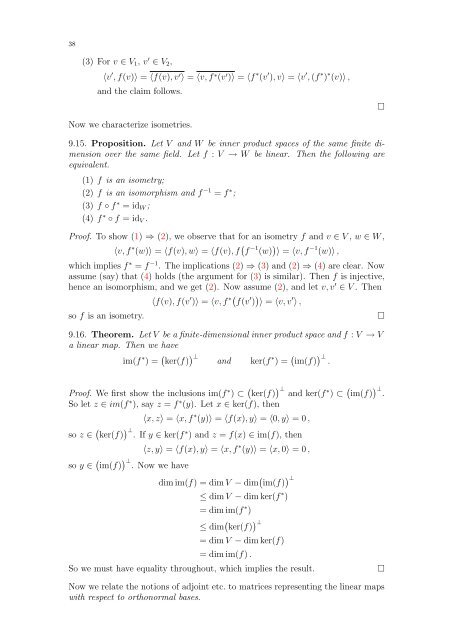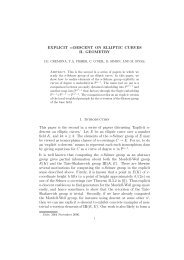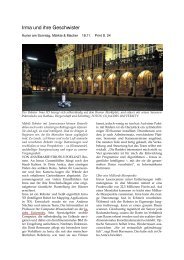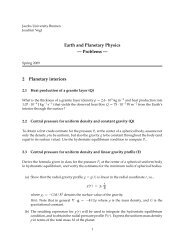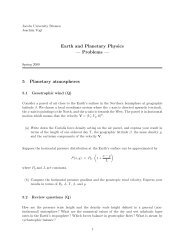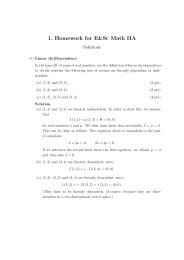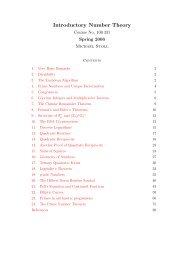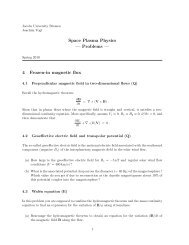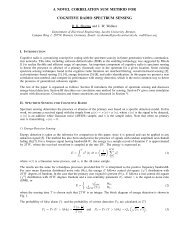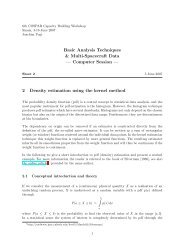Linear Algebra II (pdf, 500 kB)
Linear Algebra II (pdf, 500 kB)
Linear Algebra II (pdf, 500 kB)
Create successful ePaper yourself
Turn your PDF publications into a flip-book with our unique Google optimized e-Paper software.
38<br />
(3) For v ∈ V1, v ′ ∈ V2,<br />
〈v ′ , f(v)〉 = 〈f(v), v ′ 〉 = 〈v, f ∗ (v ′ )〉 = 〈f ∗ (v ′ ), v〉 = 〈v ′ , (f ∗ ) ∗ (v)〉 ,<br />
and the claim follows.<br />
Now we characterize isometries.<br />
9.15. Proposition. Let V and W be inner product spaces of the same finite dimension<br />
over the same field. Let f : V → W be linear. Then the following are<br />
equivalent.<br />
(1) f is an isometry;<br />
(2) f is an isomorphism and f −1 = f ∗ ;<br />
(3) f ◦ f ∗ = idW ;<br />
(4) f ∗ ◦ f = idV .<br />
Proof. To show (1) ⇒ (2), we observe that for an isometry f and v ∈ V , w ∈ W ,<br />
〈v, f ∗ (w)〉 = 〈f(v), w〉 = 〈f(v), f f −1 (w) 〉 = 〈v, f −1 (w)〉 ,<br />
which implies f ∗ = f −1 . The implications (2) ⇒ (3) and (2) ⇒ (4) are clear. Now<br />
assume (say) that (4) holds (the argument for (3) is similar). Then f is injective,<br />
hence an isomorphism, and we get (2). Now assume (2), and let v, v ′ ∈ V . Then<br />
〈f(v), f(v ′ )〉 = 〈v, f ∗ f(v ′ ) 〉 = 〈v, v ′ 〉 ,<br />
so f is an isometry. <br />
9.16. Theorem. Let V be a finite-dimensional inner product space and f : V → V<br />
a linear map. Then we have<br />
im(f ∗ ) = ker(f) ⊥<br />
and ker(f ∗ ) = im(f) ⊥ .<br />
Proof. We first show the inclusions im(f ∗ ) ⊂ ker(f) ⊥ and ker(f ∗ ) ⊂ im(f) ⊥.<br />
So let z ∈ im(f ∗ ), say z = f ∗ (y). Let x ∈ ker(f), then<br />
〈x, z〉 = 〈x, f ∗ (y)〉 = 〈f(x), y〉 = 〈0, y〉 = 0 ,<br />
so z ∈ ker(f) ⊥ . If y ∈ ker(f ∗ ) and z = f(x) ∈ im(f), then<br />
so y ∈ im(f) ⊥ . Now we have<br />
〈z, y〉 = 〈f(x), y〉 = 〈x, f ∗ (y)〉 = 〈x, 0〉 = 0 ,<br />
dim im(f) = dim V − dim im(f) ⊥<br />
≤ dim V − dim ker(f ∗ )<br />
= dim im(f ∗ )<br />
≤ dim ker(f) ⊥<br />
= dim V − dim ker(f)<br />
= dim im(f) .<br />
So we must have equality throughout, which implies the result. <br />
Now we relate the notions of adjoint etc. to matrices representing the linear maps<br />
with respect to orthonormal bases.


